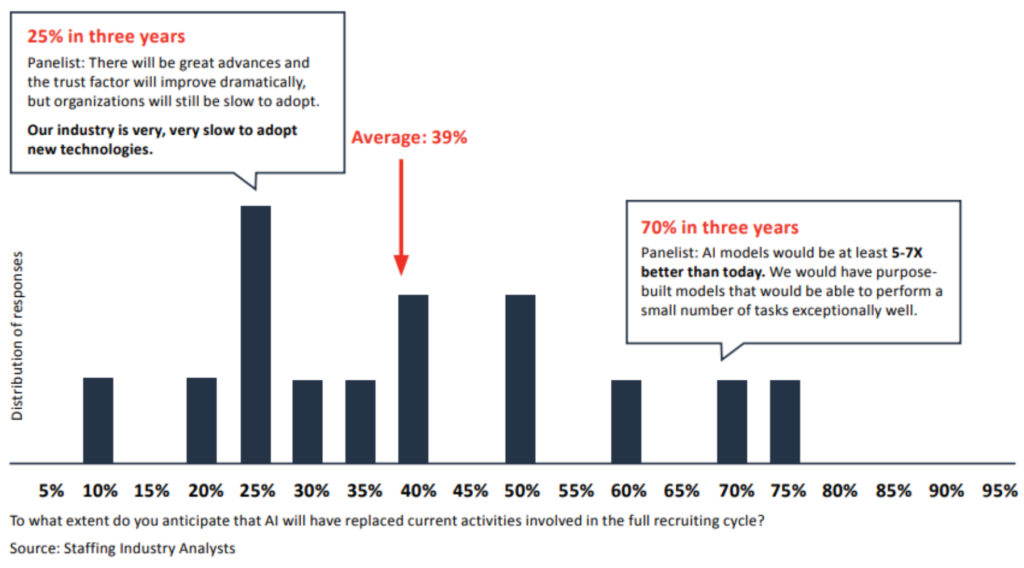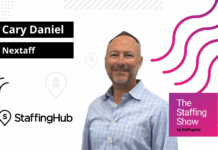
By Aseem Anand, CEO and Co-Founder of Flentis Corporation
Key Takeaways:
- AI adoption in the staffing industry is widespread and growing rapidly, with 87% of companies using AI in recruitment and an expected 30% growth in AI-driven workforce management solutions by 2028.
- AI is solving major staffing challenges through automated resume screening, skill-based matching, chatbots for candidate engagement, workforce forecasting, and cost optimization through process automation.
- While AI significantly enhances recruitment efficiency, it should augment rather than replace human judgment.
Artificial Intelligence (AI) has become as ubiquitous as air. Whether in your job, personal life, or even during your downtime, AI is nearly impossible to avoid.
From a technical standpoint, AI mimics human cognitive abilities such as decision-making, learning, and problem-solving. But in practical terms, is it a friend, a foe, or a dominator?
In the staffing industry, AI is already making its mark. Around 87% of companies incorporate AI into their recruitment processes, and according to Staffing Industry Analysts (SIA), nearly 40% of workforce-related activities could be automated within the next three years.
With a global AI market size of approximately $661.56 million in 2023, 60% of organizations employing contingent workers already use AI-driven workforce management solutions. This number is expected to grow by 30% by 2028. But the real question is: How can the staffing industry leverage AI to enhance efficiency while preserving the human element? Let’s explore.

AI solutions for staffing industry challenges
The staffing industry is undergoing a transformation, and AI is at the forefront of solving some of its most pressing challenges. Here’s how.
1. Finding and screening candidates
Challenge: Finding competent people from a large application pool is time-consuming and inefficient.
AI Solution:
- Automated resume screening: AI-powered applicant tracking systems (ATS) parse resumes, extract relevant skills, and match candidates to job descriptions faster.
- Social media sourcing: AI identifies passive candidates with desirable skills by analyzing social media and online professional networks.
- Predictive analytics: AI assesses historical hiring data to predict candidate success, reducing hiring risks.
2. Matching and selecting the right candidates
Challenge: Ensuring a strong match between a candidate’s skills and an employer’s needs.
AI Solution:
- Skill-based matching: AI improves job fit by analyzing candidate competencies and aligning them with job requirements.
- Cultural fit analysis: AI evaluates communication styles, personality traits, and job preferences to determine cultural compatibility.
- Bias reduction: AI mitigates hiring biases by focusing on skills and qualifications rather than subjective factors.
3. Candidate experience
Challenge: Keeping candidates engaged and informed throughout the hiring process.
AI Solution:
- Chatbots: AI-driven chatbots provide real-time responses, schedule interviews, and guide candidates through applications.
- Personalized communication: AI may customize applicant information and updates throughout the recruiting process.
- Automated onboarding: AI simplifies documentation and scheduling, making onboarding more seamless.
4. Workforce planning and analytics
Challenge: Accurately predicting workforce needs and skill gaps.
AI Solution:
- Talent market insights: AI analyzes labor market trends to anticipate skill shortages and hiring needs.
- Workforce forecasting: AI helps organizations decide where to source talent based on market conditions.
- Upskilling and reskilling recommendations: AI suggests training programs to close skill gaps.
5. Cost optimization
Challenge: Balancing cost efficiency with quality recruitment.
AI Solution:
- Process automation: AI reduces operational costs by automating data entry, scheduling, and reporting.
- Faster hiring cycles: AI-driven efficiency cuts down time-to-hire, reducing expenses.
- Data-driven decision-making: AI-powered analytics help staffing firms optimize pricing and profitability.
AI tools transforming recruitment
AI is not just automating tasks — it’s reshaping recruitment strategies. Here are some AI-powered tools driving change:
- Applicant tracking systems (ATS): AI-enhanced ATS streamlines resume screening, interview scheduling, and candidate ranking.
- Candidate sourcing tools: AI scours social media and job boards to find top talent.
- AI-powered screening tools: AI evaluates video interviews, skill assessments, and resumes for better candidate selection.
- Vendor management systems (VMS): AI-driven VMS optimizes contingent workforce management.
- Personalized learning platforms: AI tailors training programs to employees’ skill levels and career goals.
AI in staffing: candidates vs. recruiters
Both candidates and recruiters benefit from AI, but their applications differ.
For candidates:
- Resume enhancement: AI helps refine, format, and optimize resumes.
- Grammar and structure improvement: AI tools ensure professional and polished applications.
- Data manipulation (ethical concerns): AI should be used ethically to enhance — not fabricate — resumes.
For recruiters:
AI assists recruiters throughout the hiring process, from LinkedIn sourcing to automated screening within ATS. Tools like large language models (LLMs) enhance productivity, particularly in writing job descriptions. However, human oversight remains critical to prevent automated rejections of qualified applicants due to algorithmic biases.
Ultimately, human recruiters should remain decision-makers. AI cannot replace empathy, intuition, and personalized candidate interactions, which are vital in the hiring process.
The future of AI in staffing
The future of AI in recruitment is promising but requires a balanced approach. AI-powered tools can:
- Automate repetitive processes, increasing recruiter efficiency.
- Broaden access to a larger, more diverse talent pool.
- Help candidates refine their job search strategies.
However, AI adoption must be approached with caution. Human judgment, ethical considerations, and empathy are irreplaceable in recruitment. Both recruiters and candidates must use AI responsibly, ensuring it enhances — rather than replaces — the human touch in hiring.
AI in staffing is not about domination — it’s about augmentation. When used wisely, AI empowers staffing professionals to work smarter, not harder, ultimately leading to better hiring outcomes for all.
So, as AI continues to evolve, how do you see it shaping the future of recruitment in your industry?
 Aseem Anand is the CEO & Co-Founder of Flentis Corporation, leading the evolution of workforce management through FlentisPRO, an advanced Vendor Management System. Focused on innovation and problem-solving, he’s dedicated to building technology that streamlines contingent workforce management while offering flexibility and customization. A firm believer in open leadership, Aseem works closely with teams and clients to drive impactful solutions.
Aseem Anand is the CEO & Co-Founder of Flentis Corporation, leading the evolution of workforce management through FlentisPRO, an advanced Vendor Management System. Focused on innovation and problem-solving, he’s dedicated to building technology that streamlines contingent workforce management while offering flexibility and customization. A firm believer in open leadership, Aseem works closely with teams and clients to drive impactful solutions.





